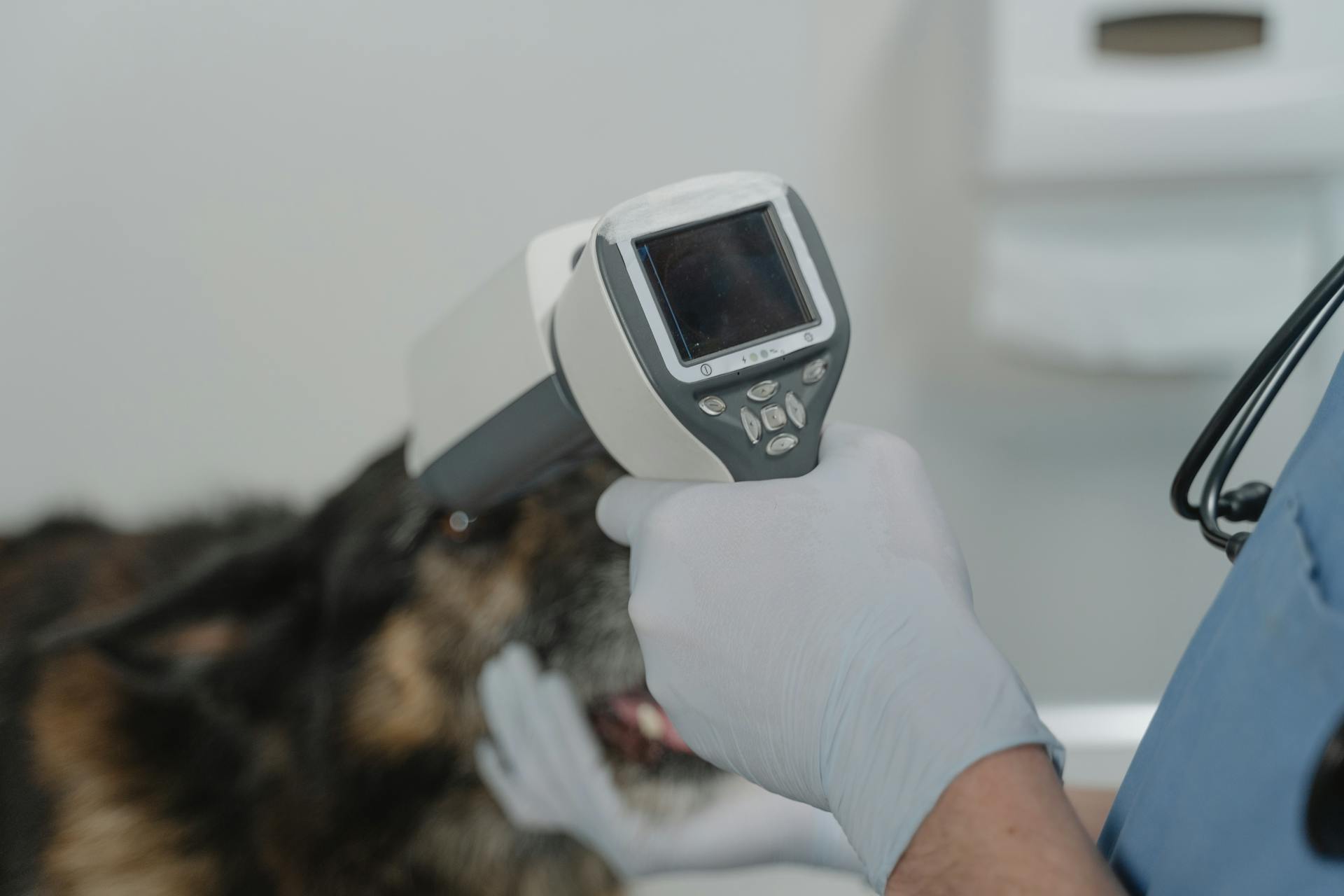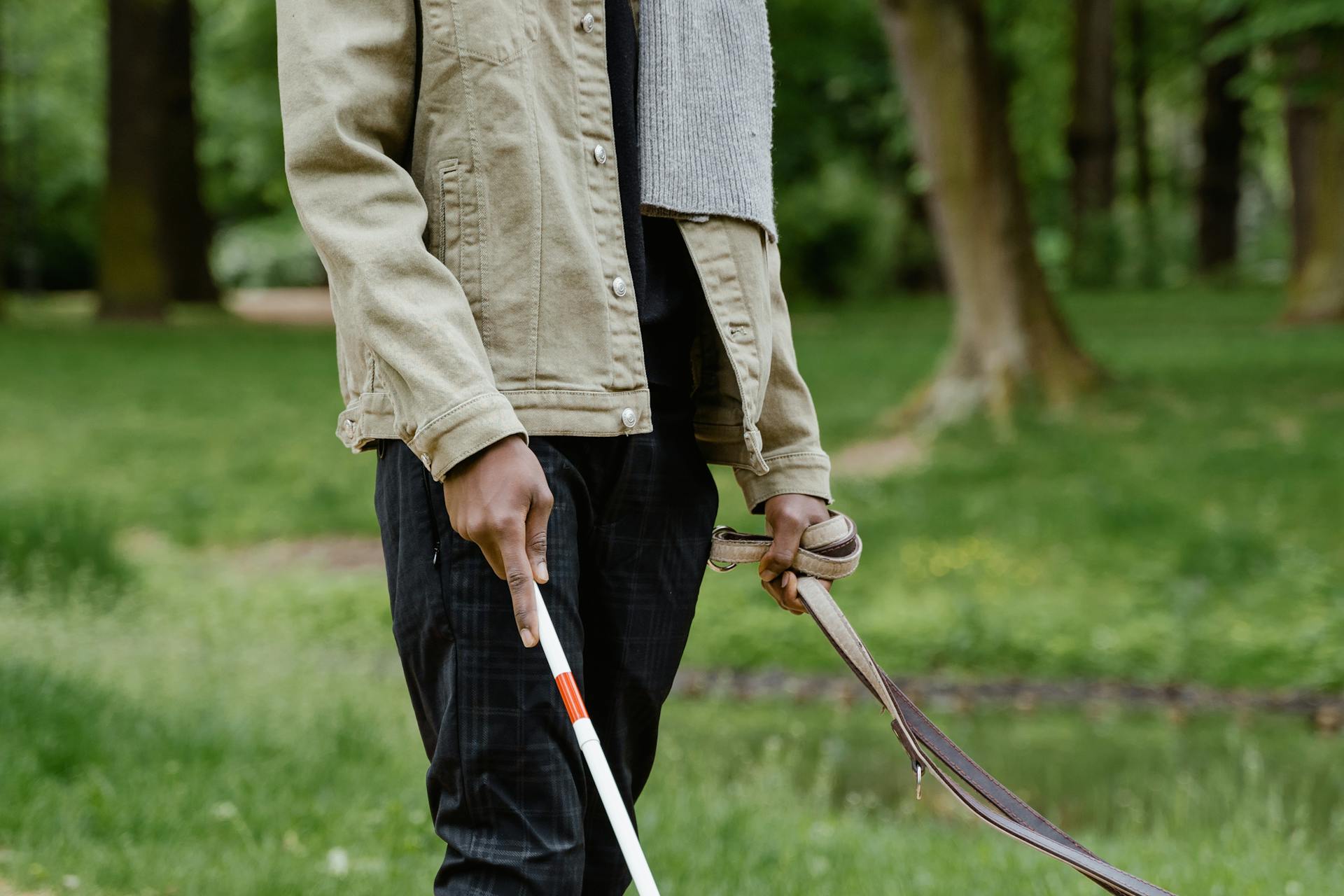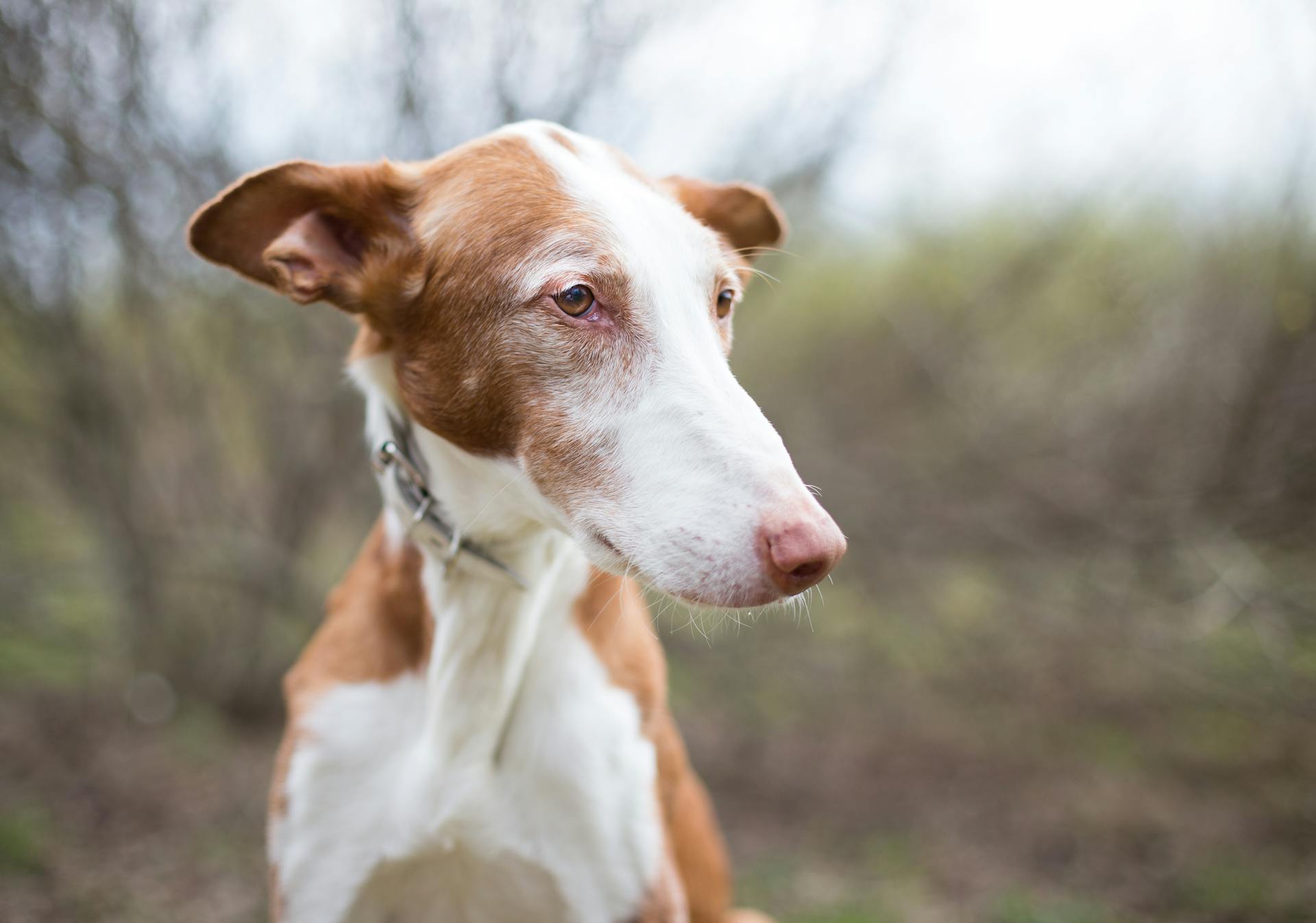
Degenerative myelopathy is a progressive disease that affects the spinal cord of dogs, causing muscle weakness and paralysis.
The disease progresses through several stages, with each stage bringing about significant changes in a dog's physical abilities and quality of life.
Stage 1 of degenerative myelopathy typically begins with subtle signs of weakness or stiffness in the hind legs.
In Stage 2, dogs often experience more pronounced hind leg weakness, making it difficult to walk or stand.
As the disease advances to Stage 3, dogs may lose the ability to walk and will often drag their hind legs.
Management options for degenerative myelopathy include physical therapy and assistive devices, such as wheelchairs or harnesses, to help maintain a dog's mobility and comfort.
Here's an interesting read: Canine Vector-borne Disease
What is Canine Degenerative Myelopathy?
Canine degenerative myelopathy (DM) is a progressive degenerative spinal cord disease that affects older dogs.
It's characterized by a non-painful progressive hind limb paralysis, which can be devastating for dog owners.
DM was previously known as chronic degenerative radiculomyelopathy (CDRM), a name that's no longer used.
Ultimately, it's a fatal disease with devastating consequences for the dogs and can be distressing for owners caring for them.
A different take: Autoimmune Disease in German Shepherds
Symptoms and Diagnosis
Degenerative myelopathy initially affects the back legs, causing muscle weakness and loss, and a lack of coordination. This leads to a staggering effect that may appear to be arthritis.
The first signs of DM can be subtle, like your dog dragging a rear foot, having a wobbly gait, or taking a wrong step here or there. With time, signs of canine DM progress to swaying, falling to the side, loss of coordination, worn nails on the rear paws, walking on their knuckles, and even difficulty getting up.
A dog with DM will initially become weak in the hind limbs and have a hard time getting up. They will lose feeling in the hind limbs, which results in dragging of the paws, scuffing of the toenails and/or tops of the paws, and abnormal paw placement.
As the disease progresses, a severely affected dog will lose the ability to stand on or move the hind limbs. If able to stand on the hind limbs, a patient’s legs may shake due to weakness.
See what others are reading: Canine Diabetes Mellitus Symptoms
The progression of the disease is generally slow but highly variable, with a dog being crippled within a few months or surviving as long as three years or more.
Common Symptoms:
- Dragging of the paws
- Scuffing of the toenails and/or tops of the paws
- Abnormal paw placement
- Wobbly gait
- Difficulty getting up
- Loss of coordination
- Swaying and falling to the side
- Walking on their knuckles
- Weakness in the hind limbs
- Loss of feeling in the hind limbs
- Muscle wasting in the hind limbs
- Incontinence
- Paralysis of the back legs
- Extensive muscle atrophy and paralysis
- Cranial nerve or respiratory muscle involvement
DM Symptoms
Degenerative myelopathy (DM) is a serious condition that affects dogs, and it's essential to recognize the symptoms early on to provide proper care. DM initially affects the hind legs, causing muscle weakness and loss of coordination, which can lead to a staggering effect that may resemble arthritis.
The first signs of DM can be subtle, such as dragging a rear foot, having a wobbly gait, or taking a wrong step. This can progress to swaying, falling to the side, loss of coordination, worn nails on the rear paws, walking on their knuckles, and even difficulty getting up.
A dog with DM will typically lose feeling in the hind limbs, resulting in dragging of the paws, scuffing of the toenails and/or tops of the paws, and abnormal paw placement. They may also be wobbly and may knuckle over the paws, cross the hind limbs, or stumble while walking.

As the condition progresses, a severely affected dog will lose the ability to stand on or move the hind limbs. If able to stand on the hind limbs, a patient's legs may shake due to weakness. In the later stage of the disease, a patient may have problems with fecal and urinary incontinence.
Some common symptoms of DM include:
- Difficulty rising from a resting position
- The hind area “gives out” causing the dog to stumble
- Dogs develop a very weak and wobbly walk
- Inability to walk up steps or hills
- Inability to perform exercises or run
- Pain in the joint in the hind area due to nerve damage
It's essential to note that DM can be misinterpreted as a chronic orthopaedic disease, such as hip or stifle (knee) issues, so it's crucial to have your dog examined by a veterinarian if you suspect DM.
Diagnosis
Degenerative myelopathy is a diagnosis of elimination, which means that other diseases with similar symptoms have to be ruled out first. This process can be time-consuming and requires a thorough examination of your dog.
Your veterinarian will evaluate your dog for spinal and joint pain, and perform a neurologic evaluation to develop a list of likely causes for your dog's clinical signs. They may recommend that you meet with a board-certified veterinary neurologist.

Radiographs (x-rays) may be recommended to evaluate the bones of the spine and hips, but the spinal cord is not visible on x-rays. Advanced imaging, such as a myelogram, CT, or MRI, can look for compression of the spinal cord and is usually recommended by a neurologist.
A diagnosis of degenerative myelopathy is made by ruling out other disorders, such as severe arthritis or spinal stenosis. Your veterinarian will also check for herniated discs, disc disorders, tumors, cysts, and infections.
Bloodwork, urinalysis, and other tests may be taken to rule out other medical conditions. Your veterinarian may also perform imaging techniques on your dog's spinal cord to evaluate the severity of the condition.
Degenerative myelopathy is often diagnosed in older dogs, who may be affected by more than one disease process. Intervertebral disc disease, for example, can also cause rear end weakness, making diagnosis more challenging.
A diagnosis of degenerative myelopathy is based on clinical signs, breed, and age, and is supported by the absence of other clinical diseases. Advanced diagnostic imaging, such as an MRI scan of the spinal cord, and cerebrospinal fluid analysis may be recommended to confirm the diagnosis.
Take a look at this: Canine Lupus
Stages and Treatment
Degenerative myelopathy is an irreversible, progressive disease that affects dogs, and it's essential to understand its stages and treatment options. The disease is divided into four clinical stages, each with distinct symptoms. Stage 1 involves decreased sensation and weakness in the hind limbs, while Stage 4 is characterized by complete paralysis in all four limbs.
The length of time between stages varies, depending on the dog's size and breed. Larger dogs typically require euthanasia before smaller dogs with similar symptoms, due to the increased difficulty in caring for them. Your veterinarian will monitor your dog's progression using a staging system.
Treatment options are limited, but laser therapy has shown promise in slowing the progression of the disease. In addition to laser therapy, rehabilitation and acupuncture may be beneficial. Your veterinarian may also recommend using dog wheelchairs, ramps, and boots to support your dog's mobility and comfort.
Early intervention with antioxidants, diet, exercise, and stimulation can support dogs with DM. Consider using dog wheelchairs, ramps, and boots, as well as soft bedding to prevent bedsores.
Causes of

Degenerative myelopathy is a complex disease, and researchers are still working to understand its causes. A mutation in the SOD1 gene is a known risk factor for developing the disease in several breeds, and it's also associated with a similar condition in humans called Lou Gehrig's disease.
Genetic mutations are a significant factor in degenerative myelopathy, with over 100 SOD1 gene mutations identified in humans with familial amyotrophic lateral sclerosis. This highlights the potential for canine DM to serve as a useful animal model for studying ALS.
Spinal cord compression, which can be caused by conditions like disc disease or tumors, can mimic the signs of degenerative myelopathy. It's essential to rule out these known causes before accepting the diagnosis of DM.
Research suggests that genetics, breed predisposition, and aging may all contribute to the development of degenerative myelopathy.
Related reading: What Causes Canine Cancer
Stages
Degenerative Myelopathy (DM) is a progressive disease that affects a dog's nervous system, leading to a decline in their quality of life. The disease progresses through four distinct clinical stages.

Stage 1 is characterized by decreased sensation and weakness in the hind limbs, making it difficult for the dog to rise from a lying position. Puppies may exhibit knuckling of the paws, dragging of the feet, and stumbling or crisscrossing of the hind limbs.
In Stage 2, the dog is unable to walk on their hind limbs, and may or may not be able to stand on them. This stage is marked by severe weakness in the hind limbs.
Stage 3 is the most severe stage, where the dog experiences paralysis of the hind limbs and weakness in the front limbs. Muscle atrophy sets in, leading to a loss of muscle mass and tone. Fecal and urinary incontinence, changes in vocalization, and difficulty swallowing food and water are also common symptoms.
Stage 4 is the final stage, where the dog is completely paralyzed in all four limbs, with muscle atrophy affecting the entire body. Fecal and urinary incontinence, changes in vocalization, difficulty swallowing, and difficulty breathing are all present.
Expand your knowledge: Masticatory Myositis Dogs
Treatment of

Treatment of degenerative myelopathy in dogs is primarily focused on managing symptoms and improving quality of life. There is no cure for the disease.
Supportive care is essential in slowing down the progression of the disease. This can include physical therapy, such as water therapy, walking with a supportive harness or sling, and range of motion exercises. Your veterinarian or neurologist can recommend rehabilitation centers near you.
Exercise, such as walking, can help strengthen the muscles that remain functional. However, it's essential to consult with your veterinarian to determine the best exercise plan for your dog. Some studies suggest that intensive physical therapy can prolong the time dogs with DM can walk.
Dietary supplements, such as fresh fruits recommended by your veterinarian, may also help slow down the progression of the disease. Aminocaproic acid and N-acetylcysteine supplements have been shown to slow the progression of DM in some studies.
Other ways to support dogs with DM include using dog wheelchairs or body harnesses, dog boots to protect their knuckles and toenails, and dog ramps to help them get on furniture or into a car.
Related reading: Canine Lymphoma Progression

Here are some additional ways to support your dog with DM:
- Using a dog wheelchair or body harness
- Using dog boots to protect their knuckles and toenails
- Using dog ramps to help them get on furniture or into a car
- Exercise, as recommended by your vet, to strengthen the muscles that remain functional
- Keeping your dog at a healthy weight
- Using soft bedding to prevent bedsores
Researchers are also exploring new treatments, such as riluzole, a drug that has been shown to prolong life in human ALS patients. A collaborative project called Project DM is underway to evaluate the safety and effectiveness of riluzole in dogs with DM.
Frequently Asked Questions
At what point do you euthanize a dog with degenerative myelopathy?
Dogs with degenerative myelopathy are typically euthanized between 6-12 months after symptoms appear, due to severe mobility loss. This can progress to complete paralysis and breathing difficulties if left untreated.
What is the end stage of degenerative myelopathy in dogs?
End-stage degenerative myelopathy in dogs is characterized by complete paralysis, severe muscle loss, and spinal cord degeneration affecting the head and neck. In this final stage, dogs have lost all spinal reflexes and are severely debilitated
Are dogs with degenerative myelopathy in pain?
Dogs with degenerative myelopathy are not typically in pain, but the condition can significantly impact their quality of life.
How quickly can degenerative myelopathy progress?
Degenerative myelopathy typically progresses rapidly, with most dogs becoming paraplegic within 6-12 months after diagnosis. Understanding the progression of DM is crucial for planning care and treatment options.
What can be mistaken for degenerative myelopathy?
Degenerative myelopathy can be mistaken for several other conditions, including peripheral nerve diseases, spinal cord injuries, and various inflammatory and infectious diseases. If you suspect your pet may have DM, it's essential to consult with a veterinarian for an accurate diagnosis and treatment plan.
Sources
- https://en.wikipedia.org/wiki/Canine_degenerative_myelopathy
- https://www.petmd.com/dog/conditions/musculoskeletal/degenerative-myelopathy-dogs
- https://wagwalking.com/condition/degenerative-myelopathy
- https://www.fitzpatrickreferrals.co.uk/neurology/conditions/canine-degenerative-myelopathy/
- https://www.akc.org/expert-advice/health/degenerative-myelopathy-in-dogs/
Featured Images: pexels.com


